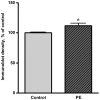Genomic and proteomic investigation of preeclampsia
- PMID: 26622380
- PMCID: PMC4509133
- DOI: 10.3892/etm.2015.2509
Genomic and proteomic investigation of preeclampsia
Abstract
The aim of this study was to use proteomic and transcriptomic approaches to examine differences in protein and gene expression in maternal plasma between normal and preeclamptic pregnancies. Preeclampsia and control groups were compared with respect to the expression of CD34 and CD133 genes by quantitative polymerase chain reaction (qPCR) and heat shock protein (Hsp)27 and 70 by western blotting in blood samples from the pregnant women. Blood samples were obtained at gestational week 12-14 from 65 healthy pregnant women. Fetal DNA was isolated from the maternal blood and CD34 and CD133 were amplified by qPCR. Western blot analysis was used to examine the expression levels of Hsp27 and Hsp70 proteins. The analysis of CD133 by qPCR was unsuccessful in 7 women as the levels of fetal DNA were in the collected maternal blood samples were insufficient. Measurements of CD34 and CD133 were performed in 57 and 50 women, respectively. Preeclampsia developed in 6 (10.5%) of 57 women. qPCR results of 8 healthy pregnant women were used for the calibration of CD34 and CD133 levels, and the results for the remaining women were compared with the calibration values. CD34 expression was decreased in 30 (52.6%) and increased in 27 (47.4%) of 57 women. CD133 expression was decreased in 14 (28%) and increased in 36 (72%) of 50 women. CD34 expression was increased in 2 (33%) and 25 (49%) and decreased in 4 (66%) and 25 (51%) women with and without preeclampsia, respectively (P=0.467). CD133 expression was increased in 4 (66%) and 32 (72%); and decreased in 2 (33%) and 12 (28%) women with and without preeclampsia, respectively (P=0.756). Western blotting showed that the expression of Hsp27 and Hsp70 in the maternal serum of the preeclampsia group was significantly higher than that in the normal pregnancy group. CD34 and CD133 were found to be inadequate for use in the prediction of preeclampsia. However, it is noteworthy that CD133 levels were increased in 66 and 72% of women with and without preeclampsia, respectively. Hsps are expressed under various pathological conditions. These results suggest that conditions of oxidative stress increased the Hsp27 and Hsp70 protein levels.
Keywords: cell-free fetal DNA; non-invasive prenatal diagnosis; preeclampsia.
Figures



Similar articles
-
[Expression and significance of heat shock protein 70 in maternal serum, umbilical cord blood and placenta of patients with hypertensive disorders complicating pregnancy].Zhonghua Fu Chan Ke Za Zhi. 2014 Sep;49(9):676-80. Zhonghua Fu Chan Ke Za Zhi. 2014. PMID: 25487454 Chinese.
-
Endoglin in pregnancy complicated by fetal intrauterine growth restriction in normotensive and preeclamptic pregnant women: a comparison between preeclamptic patients with appropriate-for-gestational-age weight infants and healthy pregnant women.J Matern Fetal Neonatal Med. 2012 Jun;25(6):806-11. doi: 10.3109/14767058.2011.595852. Epub 2011 Jul 27. J Matern Fetal Neonatal Med. 2012. PMID: 21793708
-
Effect of preeclampsia on umbilical cord blood stem cells in relation to breast cancer susceptibility in the offspring.Carcinogenesis. 2015 Jan;36(1):94-8. doi: 10.1093/carcin/bgu231. Epub 2014 Nov 14. Carcinogenesis. 2015. PMID: 25398884 Free PMC article.
-
Serum heat shock protein 70 levels in relation to circulating cytokines, chemokines, adhesion molecules and angiogenic factors in women with preeclampsia.Clin Chim Acta. 2011 Oct 9;412(21-22):1957-62. doi: 10.1016/j.cca.2011.06.042. Epub 2011 Jul 6. Clin Chim Acta. 2011. PMID: 21756887
-
Serum heat shock protein 70 in preeclampsia and normal pregnancy: A systematic review and meta-analysis.Int J Reprod Biomed. 2018 Jan;16(1):1-8. Int J Reprod Biomed. 2018. PMID: 29707695 Free PMC article. Review.
Cited by
-
Genetic Associations of Circulating Cardiovascular Proteins With Gestational Hypertension and Preeclampsia.JAMA Cardiol. 2024 Mar 1;9(3):209-220. doi: 10.1001/jamacardio.2023.4994. JAMA Cardiol. 2024. PMID: 38170504 Free PMC article.
-
Using proteomics to advance the search for potential biomarkers for preeclampsia: A systematic review and meta-analysis.PLoS One. 2019 Apr 5;14(4):e0214671. doi: 10.1371/journal.pone.0214671. eCollection 2019. PLoS One. 2019. PMID: 30951540 Free PMC article.
-
Genetic markers for preeclampsia in Peruvian women.Colomb Med (Cali). 2021 Feb 26;52(1):e2014437. doi: 10.25100/cm.v52i1.4437. Colomb Med (Cali). 2021. PMID: 33911318 Free PMC article.
-
IL-6 and IL-8: An Overview of Their Roles in Healthy and Pathological Pregnancies.Int J Mol Sci. 2022 Nov 23;23(23):14574. doi: 10.3390/ijms232314574. Int J Mol Sci. 2022. PMID: 36498901 Free PMC article. Review.
-
Cellular stress mechanisms of prenatal maternal stress: Heat shock factors and oxidative stress.Neurosci Lett. 2019 Sep 14;709:134368. doi: 10.1016/j.neulet.2019.134368. Epub 2019 Jul 9. Neurosci Lett. 2019. PMID: 31299286 Free PMC article. Review.
References
LinkOut - more resources
Full Text Sources
Other Literature Sources
Research Materials
Miscellaneous
